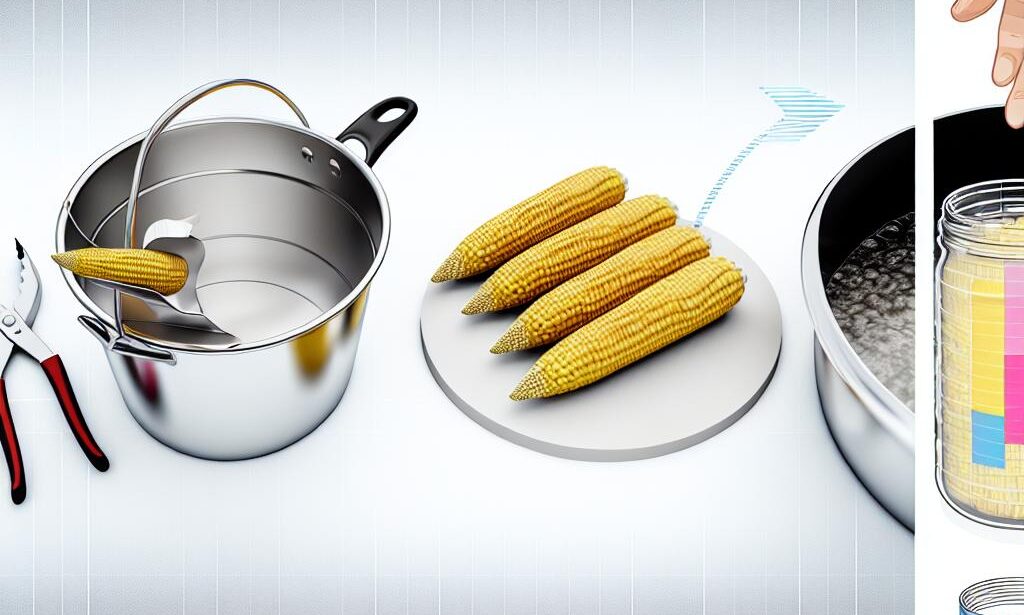Canning corn at home is a great way to preserve this versatile vegetable for year-round enjoyment. Whether you have a surplus of fresh corn from your garden or want to take advantage of seasonal sales at the grocery store, learning how to properly can corn can ensure that you have a delicious and nutritious ingredient on hand whenever you need it. In this guide, we will walk you through the steps of safely canning corn at home, so you can enjoy the taste of summer all year long.
Table of Contents
- Selecting the Best Corn for Canning
- Preparing Corn for Canning: Tips and Tricks
- Methods for Canning Corn Safely
- Storing Canned Corn: Best Practices and Recommendations
- Enjoying Your Home-Canned Corn: Serving Suggestions and Recipes
- Q&A
- To Conclude

Selecting the Best Corn for Canning
When it comes to canning corn at home, selecting the best corn is crucial to ensure a successful and delicious outcome. Here are some tips to help you choose the perfect corn for canning:
- Choose Fresh Corn: Look for corn that is fresh and in season. The kernels should be plump and juicy, with bright green husks.
- Opt for Sweet Varieties: Sweet corn varieties are ideal for canning as they retain their flavor and texture well. Some popular sweet corn varieties include Silver Queen, Honey Select, and Bodacious.
- Avoid Starchy Corn: Starchy corn varieties, such as field corn, are not suitable for canning as they can become mushy and lose their flavor during the canning process.
| Corn Variety | Characteristics |
|---|---|
| Silver Queen | Sweet and tender kernels |
| Honey Select | Golden kernels with a rich flavor |
| Bodacious | Large, juicy kernels |
By following these guidelines and , you can ensure that your canned corn is flavorful, nutritious, and perfect for enjoying year-round.

Preparing Corn for Canning: Tips and Tricks
When it comes to canning corn at home, there are a few tips and tricks that can help make the process easier and more efficient. One important step is to start with fresh, high-quality corn. Look for ears that are firm, plump, and free from blemishes. It’s best to use corn that has been picked within the last 24 hours for optimal flavor and texture.
Before you start preparing the corn for canning, it’s important to husk and clean the ears thoroughly. Remove the husks and silk, and rinse the ears under cold water to remove any dirt or debris. Once the corn is clean, you can cut the kernels off the cob using a sharp knife. To make this process easier, try placing a small bowl upside down inside a larger bowl to catch the kernels as they fall.
Another helpful tip is to blanch the corn before canning to help preserve its color, flavor, and texture. To blanch the corn, simply boil it in water for a few minutes, then immediately transfer it to an ice bath to stop the cooking process. Once the corn is blanched, you can pack it into sterilized jars and process them in a pressure canner according to the manufacturer’s instructions.
Methods for Canning Corn Safely
When it comes to canning corn safely at home, there are a few methods you can follow to ensure that your canned corn is delicious and free from harmful bacteria. One popular method is the pressure canning method, which involves using a pressure canner to safely can corn at high temperatures. This method is recommended for low-acid foods like corn to prevent the growth of botulism.
Another method for canning corn safely is the hot water bath method. This method involves submerging jars of corn in boiling water for a specific amount of time to kill any bacteria present. While this method is not as foolproof as pressure canning, it can still be effective for canning corn if done correctly. Make sure to follow a trusted recipe and proper canning guidelines to ensure the safety of your canned corn.

Storing Canned Corn: Best Practices and Recommendations
When it comes to storing canned corn, there are a few best practices and recommendations to keep in mind to ensure the quality and safety of your preserved corn. Here are some tips to help you properly store your canned corn:
- Store in a cool, dark place: It is important to store your canned corn in a cool, dark place to prevent exposure to light and heat, which can cause the corn to spoil.
- Check for signs of spoilage: Before consuming your canned corn, always check for any signs of spoilage such as bulging lids, strange odors, or discoloration.
- Rotate your stock: To ensure that your canned corn stays fresh, make sure to rotate your stock by using the oldest cans first and replacing them with newer ones.
| Storage Tips | Recommendations |
|---|---|
| Keep in a cool, dark place | Avoid exposure to light and heat |
| Check for spoilage | Look for bulging lids, strange odors, or discoloration |
| Rotate your stock | Use oldest cans first and replace with newer ones |

Enjoying Your Home-Canned Corn: Serving Suggestions and Recipes
Once you have successfully canned your corn at home, it’s time to enjoy the fruits of your labor! There are many delicious ways to incorporate your home-canned corn into meals, whether as a side dish or as part of a main course. Here are some serving suggestions and recipes to help you make the most of your home-canned corn:
- Corn Salad: Mix your home-canned corn with diced tomatoes, red onion, avocado, and a vinaigrette dressing for a refreshing and colorful salad.
- Corn Chowder: Use your home-canned corn as a base for a creamy and comforting corn chowder, perfect for a cozy night in.
- Corn Salsa: Combine your home-canned corn with black beans, bell peppers, cilantro, and lime juice for a zesty salsa that pairs well with tortilla chips or grilled meats.
Experiment with different flavor combinations and cooking techniques to discover new ways to enjoy your home-canned corn. Whether you’re looking for a quick and easy side dish or a hearty main course, your canned corn can be a versatile ingredient in your kitchen.
Q&A
Q: What equipment do I need to can corn at home?
A: To can corn at home, you will need a pressure canner, canning jars with lids and bands, a jar lifter, a canning funnel, a bubble remover tool, and a sharp knife for cutting the corn off the cob.
Q: How do I prepare the corn for canning?
A: To prepare the corn for canning, you will need to shuck the corn, remove the silk, and cut the kernels off the cob. It is important to use fresh, high-quality corn for the best results.
Q: What is the process for canning corn at home?
A: The process for canning corn at home involves packing the corn kernels into sterilized jars, adding hot water and salt, removing air bubbles, wiping the jar rims, and processing the jars in a pressure canner according to the recommended time and pressure for your altitude.
Q: How long can canned corn be stored?
A: Canned corn can be stored for up to one year in a cool, dark place. It is important to check the seals on the jars before consuming the corn and to discard any jars with compromised seals.
Q: Are there any safety tips to keep in mind when canning corn at home?
A: When canning corn at home, it is important to follow proper canning procedures to prevent the growth of harmful bacteria. This includes using a pressure canner for processing, ensuring the jars are properly sealed, and storing the canned corn in a cool, dark place. It is also important to follow a tested recipe to ensure the safety of the canned product.
To Conclude
In conclusion, canning corn at home is a great way to preserve this delicious and nutritious vegetable for year-round enjoyment. By following the steps outlined in this guide, you can ensure that your canned corn is safe to eat and maintains its quality. Whether you’re a seasoned canner or new to the process, with a little practice and the right equipment, you’ll be able to enjoy the taste of fresh corn long after the harvest season has ended. Happy canning!

